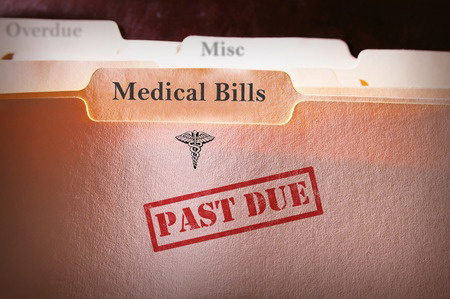The primary difference between a Chapter 7 bankruptcy and a Chapter 13 bankruptcy is that a Chapter 7 bankruptcy can eliminate debt in a period of three to four months compared to the three to five years it takes to complete a Chapter 13 plan. Under certain circumstances, a Chapter 13 bankruptcy can be converted into a Chapter 7 bankruptcy.
We recently discussed several aspects of bankruptcy with Christopher Holmes and Jess M. Smith, III, partners at Tom Scott & Associates, P.C. The discussion covered several topics, including the means test, the differences between Chapter 7 and Chapter 13, how divorce and child support can affect bankruptcy, and the discharge process. Below is Part 2 of 4 of the transcript of that conversation.
Q: For a debtor, in terms of moving forward with your life after you declare bankruptcy, what are the differences between between Chapter 7 versus Chapter 13? How does that affect your credit score or your standing in the financial world?
Jess Smith, III: In the short-term, a Chapter 7 is probably more advantageous, because when you’re in a Chapter 13 there’s always the risk that you won’t complete the plan and you’ll become eligible to convert it to a Chapter 7. Therefore, you can add debt to your bankruptcy that accrue from the time you file your Chapter 13 to when you convert to your Chapter 7. That makes lenders nervous about extending credit to you while the Chapter 13 is open, because they could take a hit.
Chris Holmes: I always tell people you’re in a case for three to four months under Chapter 7. Your done and you can do whatever you want. In a Chapter 13, you can’t borrow money without permission of the trustee or the judge. As Jess pointed out, debts that are incurred after the filing of the case, if they change their mind and switch to a Chapter 7, they can be thrown into the mix for discharge.
Q: So what would be the circumstance in which someone could switch from a Chapter 13 to a Chapter 7?
JS: A loss of income is the primary one.
CH: People start out and maybe they’re too rich. they make $100,000 a year and can pay back some of the debt. Then their job goes overseas and they’re making $10 an hour; income plummets; no money left over for the creditors; case is no longer feasible. And so we switch to a Chapter 7, dispense with the monthly payments, and just wipe out the rest of the debt.
JS: Another reason someone might want to start as a Chapter 13 and contemplate having the option of a Chapter 7 later is that you have people with substantial medical issues. Perhaps they have a few creditors coming after them now, where they need that protection. But they don’t want to file Chapter 7 now, because they know they’ve got medical issues within the next eight years that are going to crop up. Some of them will go into a Chapter 13, to establish a payment plan with those existing creditors, knowing that if a medical calamity happens before the Chapter 13 is done they can convert to a Chapter 7 and add those debts.
CH: It’s kind of a way to insure against uninsured events over this three- to five-year period, so if something terrible happens—they run up $50,000 of uninsured medical debt and they can’t afford to pay it—the law says we can switch from a Chapter 13 to a Chapter 7 and move those debts. Generally speaking, when you file the case, you’re going to list the debts prior to that date. In a Chapter 13 or a 7, you can’t add debts thereafter. Unless you switch it from a Chapter 13 to a Chapter 7, so that deadline before which debts can be added moves up to the date of conversion to a Chapter 7. So, all of those debts incurred in-between, that otherwise a debtor would have been stuck with, are added to the list.
Q: It seems as if wiping out debts completely under Chapter 7 is a more drastic financial transaction. Does that affect your credit score more negatively than filing a Chapter 13?
CH: You would think that someone filing under Chapter 13 who is paying back some of the debt would get some kind of credit for that. But my understanding is that a bankruptcy is a bankruptcy is a bankruptcy to most creditors, whether it’s a Chapter 13 or a Chapter 7. People don’t get credit, in a sense, for paying back some of their debt through a Chapter 13 plan.
JS: Not until the Chapter 13 discharge, but while you’re in it you get no positive benefit from it.
CH: No one is going to pat you on the back and say, “You’re paying back some of your debt, here I’ll give you more money.”
JS: At the end, if it shows you paid your mortgage on time and you paid your car off in full, you’ll get credit for those things. But your not going to get a boost for running into a Chapter 13 as opposed to a Chapter 7. Not in the short-term, no.
Q: But in the long-term?
JS: Potentially, yes.
CH: I tell people that supposedly debts stay on your credit reports seven to 10 years.
JS: Usually from petition date.
CH: So being in a Chapter 13 for three to five years, as opposed to a Chapter 7 for three to four months, won’t stay on your record any longer.
JS: A Chapter 13 will actually come off the credit report sooner. A Chapter 7 will be up there for up to 10 years; a Chapter 13 for about seven years.
Q: So an advantage to completing a Chapter 13, in the long-term, is that it will help you establish better credit sooner?
JS: Potentially. But in the short-term it’s the same.
CH: People always ask, “What’s a bankruptcy going to do to my credit rating?” Well, if you’ve got $50,000 of credit card debt, $30,000 of medical bills, and people are suing and garnishing and hounding you, your credit worthiness is already shot. In a weird sort of way, when you get a discharge in bankruptcy, you wipe that slate clean. You can’t file another bankruptcy for eight years, but if you have decent income and no debt, I would imagine that one’s credit worthiness is going to be enhanced by wiping the slate clean. We have debtors who tell us that just weeks later they start getting inundated with car loan applications, even though they’re in a bankruptcy. I assume that’s because the creditors are sophisticated enough to know they can’t file another bankruptcy and they can’t add any post-filing debt to the bankruptcy. So, any car loan after the filing can’t be added; they can’t file another Chapter 7 for eight years, and they’ve got decent income and they know all of this debt is going to be wiped out, a new loan can’t be discharged. I assume that’s why they are aggressively marketing to those people.
Q: So, you can’t file another Chapter 7 for eight years after having filed a Chapter 7?
CH: Date of filing plus eight years.
Q: How about if you file for Chapter 13, then complete that 60-month plan and the bankruptcy is discharged?
JS: If you file a Chapter 13 first and complete it, you can file a Chapter 7 six years after your Chapter 13 filing date, under certain circumstances. If you file a Chapter 7 first and then you file a Chapter 13, it has to be four years after your Chapter 7 filing to be eligible for a discharge. We have people who file them so close together they’re not eligible for any discharges. They complete an umbrella, so they can get their things sorted out. With an umbrella, the creditors are told to stay, while the debtor makes some sort of a payment plan. We have people complete those payment plans and then they still have to deal with the debt, because it wasn’t discharged. But, in the interim, that period of the five-year window, they’re able to live their lives and try to get their affairs in order.
CH: Or we put them in one of these bankruptcies just long enough until finally it’s been long enough to file a bankruptcy from which they can get a discharge. So, we let the case be dismissed and then re-file when it’s been long enough.
JS: I just placed someone into a Chapter 13 where basically the primary purpose was that her main debt was student loans. She made about $70,000 salary and, based on her household size, she could file a Chapter 7. But the student loan creditor said, “You owe us over $100,000, so we’re going to administratively garnish 15% of your wages. And she said, “No you’re not. I’m going to file a Chapter 13 and I’m going to pay you $500 a month for the next five years, so I can get my kids out of the house.” Otherwise she knew that 15% was going to have her end up being evicted, because it was too much of her income.
CH: Another reason we do Chapter 13 filings is because student loans are nondischargeable. If, for example, the debtor has other problems and the student loans is just too burdensome, we put them in a Chapter 13, so they can keep the student loan creditor at bay for five years. Meanwhile they can resolve some other cash issues or save their house or do whatever they need to do. But then, of course, because it’s nondischargeable, down the road that student loan is still there. Chances are that what was paid to the student loan through the five year plan won’t cover the interest that accumulates, so that student loan is probably going to be bigger. But at least they can get rid of all their other financial problems and then they can focus on the student loan at the end of five years. Hopefully at that time the money that was in the plan to solve other problems will be there to solve the student loan five years down the road.
JS: We refer to that as a Chapter 26. That’s when you get through your first Chapter 13 and shed everything but the student loan, and then if you’ve got all of the kids out of the house, maybe you’re in another Chapter 13 where your student loan is your only creditor and you try to knock it out during the second five-year plan.
Q: So, regardless of whether you file Chapter 7 or Chapter 13, student loans are not dischargeable?
JS: Correct. By and large, with rare exceptions.
Q: And that’s the same for federal taxes?
CH: Well, no. Taxes are a little different, although that gets complicated, too. But, generally speaking, if the taxes are less than three years old, you’ve got to pay them back. Taxes more than three years old may be dischargeable, but then you have to worry about whether there is a federal tax lien. Some of the tax might have to be paid back. I’m about to file a case for a debtor who had some taxes owed for 2012. The clock didn’t start ticking until April 15, 2013, because taxes are always due by April 15 the following year. So, I said to her, “Look, you’ve got all of these taxes owed for 2012; we don’t have to file your bankruptcy sooner than later. Let’s wait until after April 15, 2016, so they’ll be more than three years old and then maybe those 2012 taxes will be treated just like a credit card or medical bill, and be totally wiped out.” The threat was that in the interim, unbeknownst to me, the IRS filed a tax lien, which would make some of the tax payable. The hope is that the tax is going to fall off as a dischargeable debt.
Part 1 of Conversation: Means Test Helps Determine Filing For Chapter 7 or Chapter 13 Bankruptcy
Part 3 of Conversation: Divorce and Child Support Can Impact a Bankruptcy
Part 4 of Conversation: Being Discharged From Bankruptcy

 When foreclosure of a house is a threat, many homeowners seek debt relief through bankruptcy. A fairly common theme in this type of situation is the presence of a second mortgage. Another common aspect in this scenario is that homeowners are unaware of the second mortgage on their home. How does this happen?
When foreclosure of a house is a threat, many homeowners seek debt relief through bankruptcy. A fairly common theme in this type of situation is the presence of a second mortgage. Another common aspect in this scenario is that homeowners are unaware of the second mortgage on their home. How does this happen?